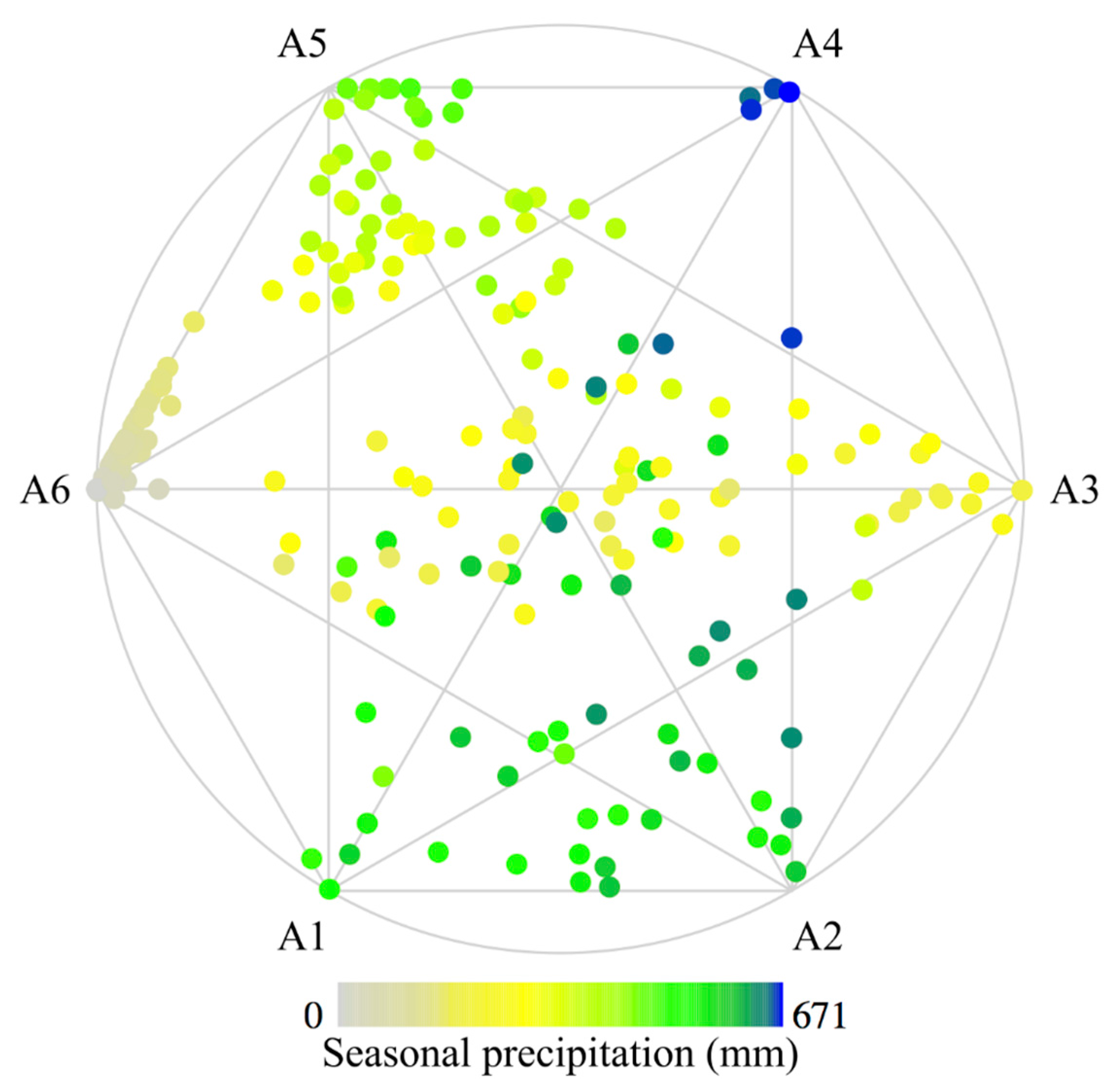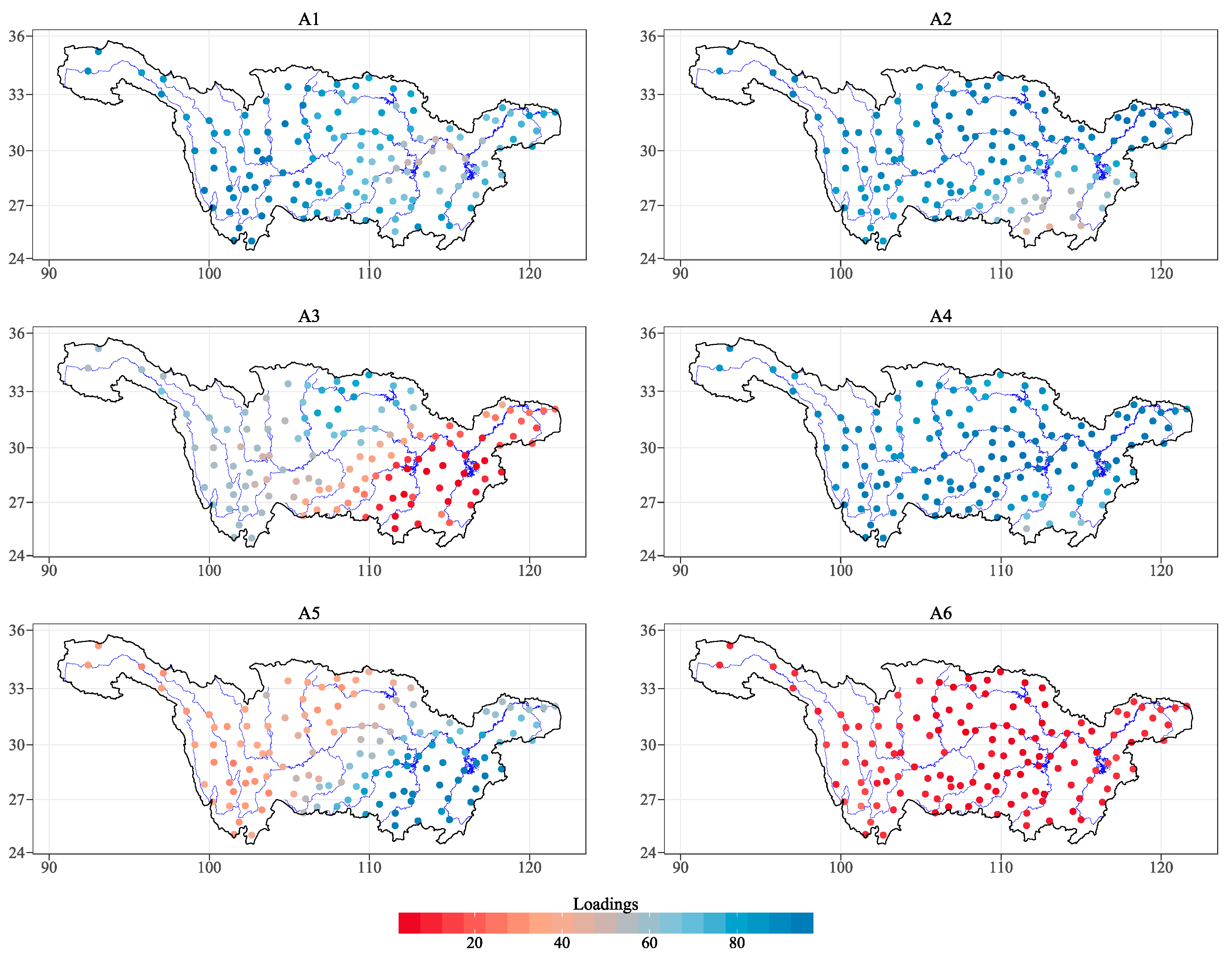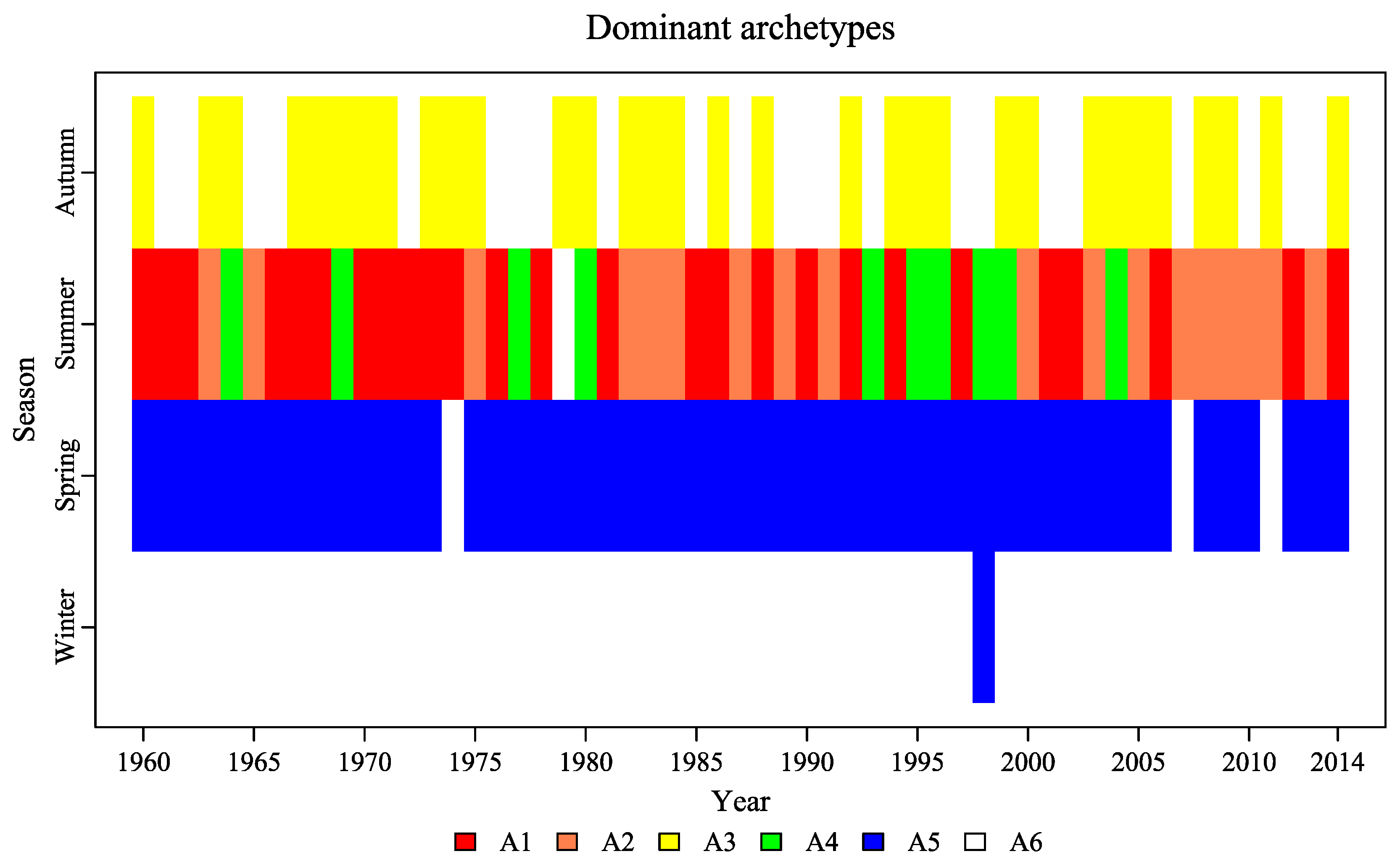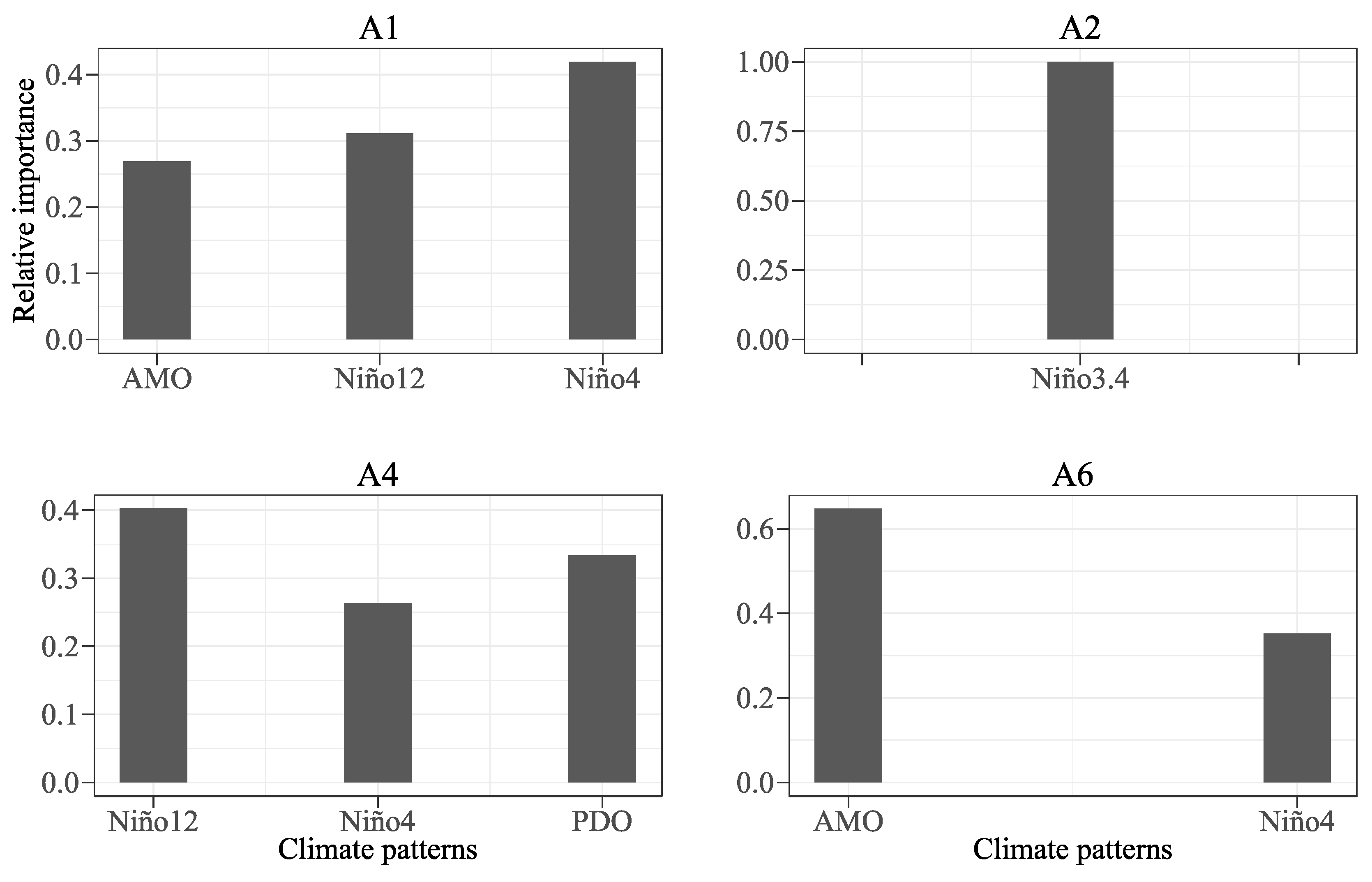Spatiotemporal Variability of Extreme Summer Precipitation over the Yangtze River Basin and the Associations with Climate Patterns
Abstract
:1. Introduction
- (1)
- Analyze the spatiotemporal variability of extreme season-scale precipitation through the AA, and perform the trend analysis of the archetype occurrence;
- (2)
- Identify the most variable seasonal precipitation that more archetypes dominate; and
- (3)
- Discuss the underlying physical mechanisms of how the climate patterns influence the variability of the extreme precipitation.
2. Data Sources
3. Methodology
3.1. Spatiotemporal Modes of Seasonal Extreme Precipitation
3.2. Trend Analysis of the Archetype Occurrence
3.3. Climate Teleconnections to the Extreme Precipitation
4. Results and Discussion
4.1. Archetypal Analysis of the Seasonal Precipitation
4.2. Trend Analysis of the Archetype Occurrence
4.3. Climate Teleconnections to the Archetypes of Summer Precipitation
4.4. Discussion of the Physical Mechanisms for Climate Teleconnections to the Extreme Precipitation during Summer
5. Conclusions
Acknowledgments
Author Contributions
Conflicts of Interest
References
- Zhang, L.X.; Zhou, T.J. Drought over East Asia: A Review. J. Clim. 2015, 28, 3375–3399. [Google Scholar] [CrossRef]
- Jiang, T.; Zhang, Q.; Zhu, D.M.; Wu, Y.J. Yangtze floods and droughts (China) and teleconnections with ENSO activities (1470–2003). Quat. Int. 2006, 144, 29–37. [Google Scholar] [CrossRef]
- Kripalani, R.H.; Kulkarni, A. Monsoon rainfall variations and teleconnections over South and East Asia. Int. J. Climatol. 2001, 21, 603–616. [Google Scholar] [CrossRef]
- Bing, L.F.; Shao, Q.Q.; Liu, J.Y. Runoff characteristics in flood and dry seasons based on wavelet analysis in the source regions of the Yangtze and Yellow rivers. J. Geogr. Sci. 2012, 22, 261–272. [Google Scholar] [CrossRef]
- Heng, L.; Xu, Z.K. The 1998 floods of the Yangtze river, China. Nat. Resour. 1999, 35, 14–21. [Google Scholar]
- Zong, Y.Q.; Chen, X.Q. The 1998 flood on the Yangtze, China. Nat. Hazards 2000, 22, 165–184. [Google Scholar] [CrossRef]
- Gemmer, M.; Jiang, T.; Su, B.; Kundzewicz, Z.W. Seasonal precipitation changes in the wet season and their influence on flood/drought hazards in the Yangtze River Basin, China. Quat. Int. 2008, 186, 12–21. [Google Scholar] [CrossRef]
- Jiang, T.; Kundzewicz, Z.W.; Su, B. Changes in monthly precipitation and flood hazard in the Yangtze River Basin, China. Int. J. Climatol. 2008, 28, 1471–1481. [Google Scholar] [CrossRef]
- Zhang, Z.; Zhang, J.; Sheng, R. The seasonal precipitation and floods/droughts in the Yangtze River Basin. J. Qingdao Technol. Univ. 2010, 31, 67–72. (In Chinese) [Google Scholar]
- Xiao, M.Z.; Zhang, Q.; Singh, V.P. Influences of ENSO, NAO, IOD and PDO on seasonal precipitation regimes in the Yangtze River basin, China. Int. J. Climatol. 2015, 35, 3556–3567. [Google Scholar] [CrossRef]
- Linderholm, H.W.; Seim, A.; Ou, T.H.; Jeong, J.H.; Liu, Y.; Wang, X.C.; Bao, G.; Folland, C. Exploring teleconnections between the summer NAO (SNAO) and climate in East Asia over the last four centuries—A tree-ring perspective. Dendrochronologia 2013, 31, 297–310. [Google Scholar] [CrossRef]
- Li, S.L.; Jing, Y.Y.; Luo, F.F. The potential connection between China surface air temperature and the Atlantic Multidecadal Oscillation (AMO) in the Pre-industrial Period. Sci. China Earth Sci. 2015, 58, 1814–1826. [Google Scholar] [CrossRef]
- Yuan, F.; Berndtsson, R.; Uvo, C.; Zhang, L.; Jiang, P. Summer precipitation prediction in the source region of the Yellow River using climate indices. Hydrol. Res. 2016, 47, 847–856. [Google Scholar] [CrossRef]
- Yuan, F.; Yasuda, H.; Berndtsson, R.; Uvo, C.B.; Zhang, L.; Hao, Z.; Wang, X. Regional sea surface temperatures explain spatial and temporal variation of summer precipitation in the source region of the Yellow River. Hydrol. Sci. J. 2016, 61, 1383–1394. [Google Scholar] [CrossRef]
- Steinschneider, S.; Lall, U. Daily precipitation and tropical moisture exports across the Eastern United States: An application of archetypal analysis to identify spatiotemporal structure. J. Clim. 2015, 28, 8585–8602. [Google Scholar] [CrossRef]
- Westra, S.; Brown, C.; Lall, U.; Sharma, A. Modeling multivariable hydrological series: Principal component analysis or independent component analysis? Water Resour. Res. 2007, 43. [Google Scholar] [CrossRef]
- Chan, B.H.P.; Mitchell, D.A.; Cram, L.E. Archetypal analysis of galaxy spectra. Mon. Not. R. Astron. Soc. 2003, 338, 790–795. [Google Scholar] [CrossRef]
- Marinetti, S.; Finesso, L.; Marsilio, E. Archetypes and principal components of an IR image sequence. Infrared Phys. Technol. 2007, 49, 272–276. [Google Scholar] [CrossRef]
- Eugster, M.J.A. Performance profiles based on archetypal athletes. Int. J. Perform. Anal. Sport 2012, 12, 166–187. [Google Scholar]
- Ragozini, G.; Palumbo, F.; D’Esposito, M.R. Archetypal analysis for data-driven prototype identification. Stat. Anal. Data Min. 2017, 10, 6–20. [Google Scholar] [CrossRef]
- China Meteorological Data Service Center (CMDC). Available online: http://data.cma.cn/en (accessed on 1 March 2017).
- Huang, B.Y.; Banzon, V.F.; Freeman, E.; Lawrimore, J.; Liu, W.; Peterson, T.C.; Smith, T.M.; Thorne, P.W.; Woodruff, S.D.; Zhang, H.M. Extended reconstructed sea surface temperature version 4 (ERSST.v4). Part I: Upgrades and intercomparisons. J. Clim. 2015, 28, 911–930. [Google Scholar] [CrossRef]
- Folland, C.K.; Knight, J.; Linderholm, H.W.; Fereday, D.; Ineson, S.; Hurrell, J.W. The summer north Atlantic oscillation: Past, present, and future. J. Clim. 2009, 22, 1082–1103. [Google Scholar] [CrossRef]
- Knight, J.R.; Folland, C.K.; Scaife, A.A. Climate impacts of the Atlantic Multidecadal Oscillation. Geophys. Res. Lett. 2006, 33. [Google Scholar] [CrossRef]
- Mantua, N.J.; Hare, S.R.; Zhang, Y.; Wallace, J.M.; Francis, R.C. A Pacific interdecadal climate oscillation with impacts on salmon production. Bull. Am. Meteorol. Soc. 1997, 78, 1069–1079. [Google Scholar] [CrossRef]
- KNMI Climate Explorer. Available online: https://climexp.knmi.nl/start.cgi?id=someone@somewhere (accessed on 1 March 2017).
- Cutler, A.; Breiman, L. Archetypal analysis. Technometrics 1994, 36, 338–347. [Google Scholar] [CrossRef]
- Stone, E.; Cutler, A. Introduction to archetypal analysis of spatio-temporal dynamics. Phys. D Nonlinear Phenom. 1996, 96, 110–131. [Google Scholar] [CrossRef]
- Eugster, M.J.A.; Leisch, F. Weighted and robust archetypal analysis. Comput. Stat. Data Anal. 2011, 55, 1215–1225. [Google Scholar] [CrossRef] [Green Version]
- Eugster, M.J.A.; Leisch, F. From spider-man to hero—Archetypal analysis in R. J. Stat. Softw. 2009, 30, 1–23. [Google Scholar] [CrossRef]
- Cleveland, W.S. Robust locally weighted regression and smoothing scatterplots. J. Am. Stat. Assoc. 1979, 74, 829–836. [Google Scholar] [CrossRef]
- Grömping, U. Relative importance for linear regression in R: The package relaimpo. J. Stat. Softw. 2006, 17. [Google Scholar] [CrossRef]
- Lindeman, R.H.; Gold, R.Z.; Merenda, P.F. Introduction to Bivariate and Multivariate Analysis; Scott Foresman: Glenview, IL, USA, 1980. [Google Scholar]
- Seth, S.; Eugster, M.J.A. Probabilistic archetypal analysis. Mach. Learn. 2016, 102, 85–113. [Google Scholar] [CrossRef]
- Chang, C.P.; Lu, M.M. Intraseasonal predictability of Siberian High and East Asian Winter Monsoon and its interdecadal variability. J. Clim. 2012, 25. [Google Scholar] [CrossRef]
- Cheng, M.H.; He, H.Z.; Mao, D.Y.; Qi, Y.J.; Cui, Z.H.; Zhou, F.X. Study of 1998 heavy rainfall over the Yangtze River Basin using TRMM data. Adv. Atmos. Sci. 2001, 18, 387–396. [Google Scholar] [CrossRef]
- Facts and Details. Available online: http://factsanddetails.com/china/cat10/sub64/item1879.html (accessed on 1 August 2017).
- Yu, J.Y.; Kao, P.K.; Paek, H.; Hsu, H.H.; Hung, C.W.; Lu, M.M.; An, S.I. Linking emergence of the Central Pacific El Niño to the Atlantic Multidecal Oscillation. J. Clim. 2014, 28, 651–662. [Google Scholar] [CrossRef]
- Zhang, Z.; Gong, D.; Hu, M.; Guo, D.; He, X.; Lei, Y. Anomalous winter temperature and precipitation events in southern China. J. Geogr. Sci. 2009, 19, 471–488. [Google Scholar] [CrossRef]
- Schlesinger, M.E.; Ramankutty, N. An oscillation in the global climate system of period 65–70 years. Nature 1994, 367, 723–726. [Google Scholar] [CrossRef]
- Si, D.; Ding, Y.H. Oceanic forcings of the interdecadal variability in East Asian summer rainfall. J. Clim. 2016, 29, 7633–7649. [Google Scholar] [CrossRef]
- Qian, C.C.; Yu, J.Y.; Chen, G. Decadal summer drought frequency in China: The increasing influence of the Atlantic multi-decadal oscillation. Environ. Res. Lett. 2014, 9. [Google Scholar] [CrossRef]
- Trenberth, K.; National Center for Atmospheric Research Staff (Eds.) The Climate Data Guide: Niño SST Indices (Niño 1 + 2, 3, 3.4, 4; ONI and TNI). Available online: https://climatedataguide.ucar.edu/climate-data/nino-sst-indices-nino-12–3-34–4-oni-and-tni (accessed on 1 August 2017).
- Guo, J.Y.; Sun, J.L.; Chang, X.T.; Guo, S.Y.; Liu, X. Correlation analysis of Niño3.4 SST and inland lake level variations monitored with satellite altimetry: Case studies of Lakes Hongze, Khanka, La-ang, Ulungur, Issyk-kul and Baikal. Terr. Atmos. Ocean. Sci. 2011, 22, 203–213. [Google Scholar] [CrossRef]
- Chen, W. Impacts of El Niño and La Niña on the cycle of the East Asian winter and summer monsoon. Chin. J. Atmos. Sci. 2002, 26, 595–610. (In Chinese) [Google Scholar]
- Wang, B.; Wu, Z.W.; Li, J.P.; Liu, J.; Chang, C.P.; Ding, Y.H.; Wu, G.X. How to measure the strength of the East Asian summer monsoon. J. Clim. 2008, 21, 4449–4463. [Google Scholar] [CrossRef]







| Climate Patterns | A1 | A2 | A4 | A6 |
|---|---|---|---|---|
| AMO | 0.27 (July–September) | 0.37 (May–July) | ||
| Niño12 | −0.28 (November–January) | 0.34 (September–November) | ||
| Niño3.4 | −0.23 (May–July) | |||
| Niño4 | −0.32 (February–April) | 0.27 (February–April) | −0.30 (March–May) | |
| PDO | 0.33 (August–October) |
© 2017 by the authors. Licensee MDPI, Basel, Switzerland. This article is an open access article distributed under the terms and conditions of the Creative Commons Attribution (CC BY) license (http://creativecommons.org/licenses/by/4.0/).
Share and Cite
Su, Z.; Hao, Z.; Yuan, F.; Chen, X.; Cao, Q. Spatiotemporal Variability of Extreme Summer Precipitation over the Yangtze River Basin and the Associations with Climate Patterns. Water 2017, 9, 873. https://doi.org/10.3390/w9110873
Su Z, Hao Z, Yuan F, Chen X, Cao Q. Spatiotemporal Variability of Extreme Summer Precipitation over the Yangtze River Basin and the Associations with Climate Patterns. Water. 2017; 9(11):873. https://doi.org/10.3390/w9110873
Chicago/Turabian StyleSu, Zhenkuan, Zhenchun Hao, Feifei Yuan, Xi Chen, and Qing Cao. 2017. "Spatiotemporal Variability of Extreme Summer Precipitation over the Yangtze River Basin and the Associations with Climate Patterns" Water 9, no. 11: 873. https://doi.org/10.3390/w9110873





